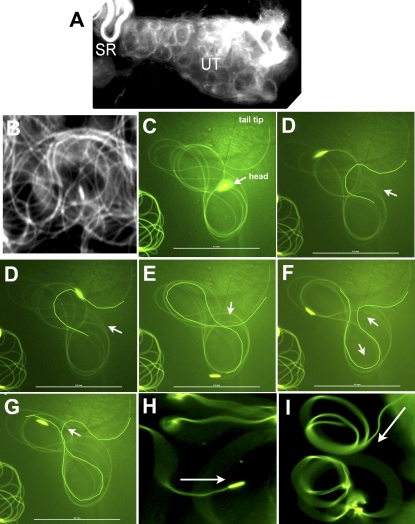FIG. 1.
The arc-line, base-to-tip, and tip-to-base waves of sperm from the uterus. Snap views of live samples are shown. A) The moving sperm (∼5000 sperm) appear as circular foci in the uterus. B) A close-up view of the sperm in A shows circularly bent flagella (Supplemental Movies 1 and 2). C–G) A sperm released from the uterus executes an arc-line waveform (Supplemental Movie 3). C) A single fly flagellum forms up to 10 arc-line bends that stack into a figure-8 configuration. D–G) Sequential snap views showing formation of new arc-line bends (highlighted). Similar to sinusoidal waves, all new bends initiate at one of the flagellar ends (the tail end in this case). The arrow points to the thrust direction of a new bend that protrudes out as an open arc that then closes. The thrust direction alternates in opposite directions. The arc-line bends propagate through the entire folded flagellum, as evidenced by the moving head as it is continuously dragged behind its flagellum on the figure-8 path. H) Tip-to-base waves are observed when the distal flagellum is anchored (Supplemental Movie 4). I) Base-to-tip waves are observed when the proximal flagellum is anchored (Supplemental Movie 5). Arrows in H and I point to the direction of wave propagation. Bar = 0.1 mm.

